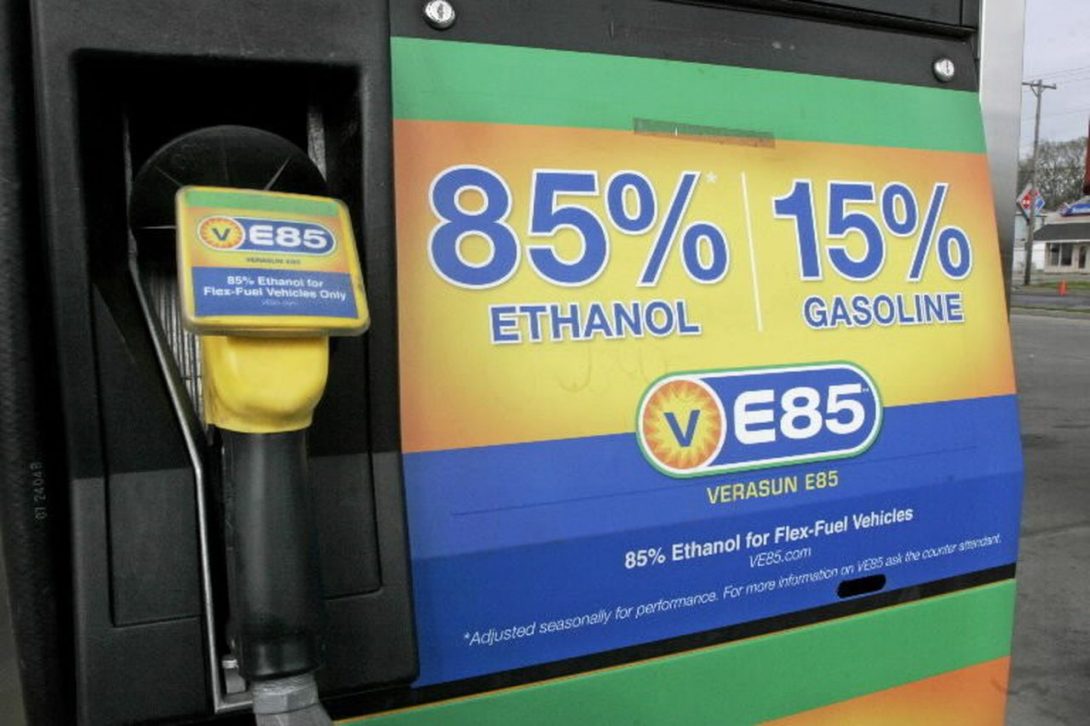Ethanol: What is it?
Ethanol is a biodegradable, renewable fuel made from corn and plant matter. Its use is widespread, as 98% of all gasoline consumed in the United States contains a blend of Ethanol. The most common blend provided, E10 (10% ethanol, 90% gasoline) can be used in any vehicle. Flex fuel vehicles (FFV) are able to fuel with E85 (up to 85% ethanol) which is considered an alternative fuel under the Energy Policy Act of 1992 (EPAct).
Ethanol is a crucial component of our nations solution to reducing our dependency on foreign oil, fossil fuels, lowering fuel prices, and cleaning the environment.

Benefits & Considerations
Emissions
The carbon dioxide released by a vehicle when ethanol is burned is offset by the carbon dioxide captured when the feedstock crops are grown to produce ethanol. This differs from gasoline and diesel, which are refined from petroleum extracted from the earth. No emissions are offset when these petroleum products are burned. On a life cycle analysis basis, greenhouse gas (GHG) emissions are reduced on average by 34% with corn-based ethanol produced from dry mills, and range between 88% and 108% if cellulosic feedstocks are used depending on feedstock type, compared with gasoline and diesel production and use. (Courtesy of Alternative Fuel Data Center.)
Fuel Economy and Performance
A gallon of ethanol contains less energy than a gallon of gasoline, resulting in lower fuel economy when operating your vehicle. The impact to fuel economy varies depending on the energy difference in the blend used. For example, E85 that contains 83% ethanol content has about 27% less energy per gallon than gasoline (the impact to fuel economy lessens as ethanol content decreases). However, ethanol has a higher octane number than gasoline, which provides increased power and performance. For example, Indianapolis 500 drivers often fuel their race cars with E98 because of its high octane. (Courtesy of DOE Alternative Data Center.)
Job Impacts
Ethanol production creates jobs in rural areas where employment opportunities are needed. According to the Renewable Fuels Association, ethanol production in 2019 accounted for more than 68,600 direct jobs across the country, $43 billion to the gross domestic product, and $23 billion in household income. (See the Pocket Guide to Ethanol 2020(PDF).
F.A.Q.
Ethanol can be fermented from many sources of starch, including corn, wheat, grain sorghum, barley, and potatoes, and from sugar crops such as sugar cane and sweet sorghum. Because there has been has been an abundant supply of corn, most of the ethanol made in the United States is from corn. Most of the ethanol is produced in the Midwest and Upper Midwest where ethanol plants are close to and have a consistent supply of corn, access to water resources, and have livestock production nearby. A by-product of ethanol production is distillers grains, which can be fed to livestock either wet or dried. Because the wet distillers grains are perishable and heavy, which adds to transportation costs, they are usually used within a 100 mile radius of an ethanol plant. Distillers grains are more stable and easier to transport when an ethanol producer dries them, however that increases the energy cost for the ethanol producer. Distillers grains retain many of the nutrients from corn, since only the starch has been removed. Due to the high fiber content most of the distillers grains are fed to beef and dairy cattle, however, they can also be used as poultry and pig feed. (Courtesy of University of Illinois Extension)
In most of the newer ethanol plants, also known as “dry grind” plants, the corn kernels are finely ground into small particles. Then water is added to the ground corn along with enzymes to convert the starch for fermentation. The mixture, also known as mash, is cooked to break the starch down further. The mash is removed from the cookers and allowed to cool before a second enzyme (glucoamalyse) is added to the mash. This enzyme helps turn the liquid starch into sugars. Yeast is added to the mash and the fermentation creates ethanol and carbon dioxide. After about two days, the fermentation process is complete and the mash is heated again. During the heating process, the ethanol evaporates into a vapor that is collected, while the remaining corn and yeast solids remain. The ethanol vapor is cooled and condenses into a liquid. This liquid is dehydrated to remove excess water from the ethanol, making “anhydrous” ethanol suitable for blending with gasoline.
There are several recent major innovations in the dry grind process that:
- improve energy efficiency
- reduce water use
- reduce the size and complexity of the ethanol plant
- recover more value-added products from the grain besides ethanol, CO2, and distillers grains.
These innovations and continuing process research are creating better economic opportunities in grain ethanol production, and are changing the ways of looking at an ethanol plant as a community investment.
Ethanol can also be produced by a wet milling process that separates the corn into several different components and affords many options for end products, including ethanol. Wet mills are much more complex, and have a much higher capital cost than dry grind plants.
Despite the established base of ethanol plants using starch-containing grains as the feedstocks, other interesting ways of making fuel alcohols by fermentation exist. Cellulose, the most abundant bio-based material on earth, consists of sugar molecules that can be broken apart and fermented by certain organisms and/or enzymes. Currently, researchers are studying ways to make ethanol from cellulose that is extracted from biomass, such as corn cobs, corn stover (stalks and leaves), straw from wheat or rice, perennial grasses, such as Miscanthus and switchgrass, and wood waste from the forestry and paper industries. (Courtesy of University of Illinois Extension.)
Ethanol is a good fuel for use in spark-ignition engines. It has a high octane number, making it attractive as an antiknock additive in gasoline. It can be used as an additive for diesel (biodiesel). Ethanol is also an important feedstock for the chemical industry. (Courtesy of University of Illinois Extension.)
A flexible fuel vehicel (FFV) has the ability to run on more than one type of gasoline. FFVs can be fueled by unleaded gasoline or by ethanol blends. Click here to search for flex fuel vehicle models.
- The Alternative Fuels Data Center is run by the US Department of Energy and provides plenty of information on all alternative fuels
- The Renewable Fuels Association has everything you need to know about ethanol in the Pocket Guide to Ethanol
- The U.S. Energy Information Administration detailed reports on production, uses, and extensive FAQs
